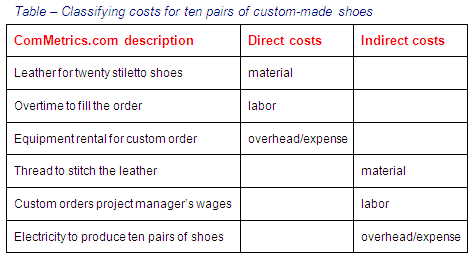Last week we launched the ComMetrics social media cost classification model. This post is the next installment in a series that addresses social media issues arising from increasing links between compensation for service providers and the value they generate for clients (pay-for-performance 2.0), in which cost-benefit issues, including ROI (return on investment), play a critical role (see also Social Media DOs and DON’Ts).
- Article source – 2 tips for better cost management with social media
 I recently spoke with a well-known workplace injury lawyer, who pointed out that estimating the increase to workers’ compensation premiums for each injury that occurs on the job is easy. The harder part to figure out is the indirect costs, which could be significantly greater than direct damages.
I recently spoke with a well-known workplace injury lawyer, who pointed out that estimating the increase to workers’ compensation premiums for each injury that occurs on the job is easy. The harder part to figure out is the indirect costs, which could be significantly greater than direct damages.
We address this issue with regard to social media marketing, of particular interest since companies like Coca-Cola are increasingly pushing for Pay-for-Performance 2.0 models to work with advertising agencies and social media service providers.
- 1. Separate direct from indirect costs
Direct costs are fully attributable to a product, service or department.
Indirect costs (also known collectively as overhead) cannot be attributed directly to a product, service or department, even though the costs were incurred while producing the good or service.
Indirect or direct costs are attributed to one of three categories – materials, labor and overhead/expenses. As such, there are
- – direct and indirect material outlays;
– direct and indirect labor costs; and
– direct and indirect expenses or overhead.
Total production cost represents the sum of all direct costs associated with producing the product or service.
Production overhead includes all indirect costs (e.g., wages, expenses and materials) that are associated with preparing the order, product or service for delivery. Administration, distribution and sales all incur indirect costs, whether in the form of wages, expenses or materials.
Get the next post about how Facebook costs matter to your ROI first by entering your e-mail right here:
- 2. Put things into practice
Distilling direct and indirect costs for social media marketing can be somewhat tricky for a beginner. The important thing to remember is that direct costs must be ‘fully traceable’ to the activity, product or department.
Unfortunately and for various reasons, not all costs can be traced back and some costs are so immaterial or negligible that it is not feasible to trace them, even if they are fully traceable.

As the table illustrates, it is impractical to trace the amount of thread used for each pair of shoes, so we have classified it as an indirect cost.
The project manager’s wages present a similar problem. If their salary and benefits can be attributed to the custom order, then they are direct costs. However, if they oversee many custom orders, they salary and benefits can only be apportioned to the ten custom-ordered shoes, meaning we cannot fully trace this cost to those twenty high-heels.
Beyond the above direct costs and production expenses, as well as overhead incurred for the custom order, additional overhead may be incurred in sales, distribution and administration.
- Bottom line
The maturity model for social media marketing provides information to understand the phase an organization finds itself in for social media use. Nevertheless, keeping track of direct and indirect costs is a must to be able to link them with benefits. In turn, the company can better explain and justify exactly why certain social media channels, such as Twitter or Facebook, are used instead of a corporate blog or vice versa.
This post focused on getting a better understanding of direct and indirect costs, and the example used (see also Table 1) should enable you to do some cost accounting of your own.
Once you have a better handle of your direct and indirect costs, you should examine your business strategy. We will illustrate this with an example with our next post: Cost accounting 101: What does Facebook really cost?
More resources
- – Why women buy black high heels: The guide to everything
– 2011 trendwatch webinar: More useless social media measures
– Webinar: How to get your Facebook expenses under control (2011-02-25 – held 2011-03-03 – 17:00 hrs)
- Taking our own advice
We are planning another webinar, entitled How to control Facebook expenses, with our best advice for making your cost accounting efforts successful. To ensure that we address the problems social media strategists deal with, we ask that you please answer a few questions.
We will choose the most interesting response and send that person a free copy of our eBook, Hold up your hand if you hate research methodology – A guide to getting the right intel online (a US$28 value).
Okay, here are the questions:
- 1. What is your company’s or brand’s Facebook page’s URL (address)?
2. How long have you had a Facebook page?
3. What is your Facebook goal/mission?
4. What is the biggest problem you are having on your Facebook fanpage?
5. How do you address the indirect and direct cost issues arising from your Facebook fanpage?
Please, leave your answers in the comments section. We will announce the winner in next week’s post, 3 insider tips: What does your Facebook page really cost?
As always, thanks for being a part of our community!
Pingback: CyTRAP
Pingback: MyComMetrics
Pingback: By @ShigoCreatives
Pingback: McCollins Media
Pingback: World Economic Forum
Pingback: creativescan
Pingback: Alex Hall
Pingback: 2 tips for better cost control on Facebook » 2011 trends, best practice, Beziehungsmarketing, cost accounting, social CRM, social media ROI, social network, KPI, cost-benefit analysis » ComMetrics Uni - social media audit, sCRM - online training